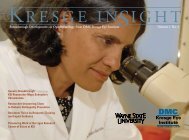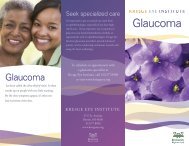Racquetball Champion Diabetic Physician - Kresge Eye Institute
Racquetball Champion Diabetic Physician - Kresge Eye Institute
Racquetball Champion Diabetic Physician - Kresge Eye Institute
- No tags were found...
You also want an ePaper? Increase the reach of your titles
YUMPU automatically turns print PDFs into web optimized ePapers that Google loves.
R esearcher Awarded 2 NEI Grants<br />
G<br />
laucoma Does Not Stop <strong>Racquetball</strong> <strong>Champion</strong><br />
Fu-Shin X. Yu, Ph.D., professor of<br />
Ophthalmology and Anatomy/Cell Biology for<br />
the Wayne State University School of Medicine,<br />
and director of research at DMC <strong>Kresge</strong> <strong>Eye</strong><br />
<strong>Institute</strong>, has received two grants from the<br />
National <strong>Eye</strong> <strong>Institute</strong> (NEI) of the National<br />
<strong>Institute</strong>s of Health.<br />
Molecular Regulation of Corneal Wound Healing<br />
In 2008, Dr. Yu was awarded a five-year, $1.9 million Research Project Grant to<br />
continue his study of “Molecular regulation of corneal wound healing.” Dr. Yu<br />
has received funding for this project since 1995.<br />
The study uses a variety of technologies to determine why diabetic patients experience<br />
delayed healing of corneal wounds and attempts to identify therapeutics<br />
that promote wound healing – an important topic with an ever-increasing<br />
diabetic patient population.<br />
Previously, the study had examined epidermal growth factor (EFG) as a therapeutic<br />
to stimulate wound healing, but EGF has proven to be less effective in<br />
diabetics than in non-diabetics.<br />
The study also found that oxidative stress caused by long-term hypoglycemia<br />
contributes to delayed wound healing. As a result, the research is investigating<br />
whether a combination of an antioxidant and EGF may be appropriate for diabetic<br />
patients who are undergoing surgery or who have a corneal wound.<br />
Mechanisms of Flagellin-Induced Protection<br />
Against Bacterial Keratitis<br />
Dr. Yu was also awarded a second grant from the NEI to identify ways the eye<br />
recognizes pathogens when the corneal barrier is breached. The study will investigate<br />
ways to enhance the innate immunity of the eye against bacterial keratitis<br />
and may lead to improvements in contact lens solution to prevent or reduce<br />
corneal infections associated with contact lens use.<br />
The $338,000 study is based on an understanding of toll-like receptors (TLR)<br />
that was uncovered in 1996. TLR are a class of proteins that alert the immune<br />
system to the presence of microbial infections and play a key role in activating<br />
immune cell responses. TLR are present in most bodily tissues, but especially in<br />
the cornea and the cilia of the lungs and intestine – parts of the body most exposed<br />
to external pathogens. They are single membrane-spanning non-catalytic<br />
receptors that recognize structurally conserved molecules derived from microbes.<br />
It has been discovered that bacterial flagellin proteins activate the TLR, producing<br />
anti-microbial peptides that prevent or significantly reduce infection.<br />
Dr. Yu is working in collaboration with researchers at another university who<br />
are applying the study results to pulmonary infection modeling.<br />
Jim Hulen of Rochester Hills, Mich.,<br />
is a three-time gold medalist in<br />
racquetball in the Senior Olympics.<br />
But the fit 75-year-old missed the<br />
competition in 2007 due to eye<br />
problems. However, Hulen has rallied<br />
back after treatment at DMC <strong>Kresge</strong><br />
<strong>Eye</strong> <strong>Institute</strong> and hopes to return to<br />
competition soon.<br />
Four years after cataract surgery Hulen started<br />
to have foggy vision in his right eye caused<br />
by spiking eye pressure temporally related to<br />
playing racquetball and running.<br />
“My eye doctor said the lens was rubbing on<br />
my iris and pigment was flaking off and this<br />
caused fluid to not drain off properly,” Hulen<br />
said.<br />
After several visits and laser surgery, Hulen<br />
was still having problems, including<br />
intraocular pressure spiking to over 60<br />
mmHg. Hulen was advised to have his lens<br />
implant replaced. He was concerned about<br />
undergoing further surgery and was not sure<br />
what to do.<br />
Finally, Hulen visited Anju Goyal, M.D.,<br />
assistant professor of Ophthalmology, Wayne<br />
State University School of Medicine, at KEI<br />
in July 2007.<br />
“During a slit lamp exam I noted that he had<br />
pigmented and white cells in the anterior<br />
chamber and translumination defects at<br />
the intraocular lens-iris junction and a<br />
few midperipherally. Gonioscopy revealed<br />
increased pigmentation with an open angle.<br />
These cells were causing the fogginess in<br />
his vision,” said Dr. Goyal. “His vision was<br />
20/20 so we wanted to avoid replacing<br />
the lens implant if possible. We were able<br />
to control his intraocular pressure for six<br />
months with topical medication. He was<br />
advised to monitor his physical activity,<br />
which was disappointing to this very active<br />
man.”<br />
Despite this treatment and lifestyle change,<br />
Hulen began experiencing symptoms with<br />
and without exercise.<br />
“When his eye pressure spiked without<br />
any pigmentary-uveitic process and did<br />
not respond to medication, we determined<br />
the best course of action would be a<br />
trabeculectomy with mitomycin C,” Dr.<br />
Goyal said.<br />
After surgery in January 2008, Hulen’s vision<br />
returned to 20/20 and his eye pressure is<br />
normal without medication.<br />
Since the surgery Hulen has “had no<br />
problems at all,” he said, and is back to his<br />
active lifestyle.<br />
www.dmc.org<br />
www.dmc.org








